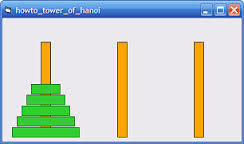Solving the Tower of Hanoi

Little Tommy is trying to solve the Tower of Hanoi with 5 disks.
The objective of the puzzle is to move the entire stack from one rod to another, following simple rules :
• Only one disk can be moved at a time.
• Each move consists of taking the upper disk from one of the stacks and placing it on top of another stack i.e. a disk can only be moved if it is the uppermost disk on a stack.
• No disk can be placed on top of a smaller disk.
His mom asks him to finish the game quickly and get back to his homework.
What is the minimum number of moves required to solve the puzzle ?
The answer is 31.
This section requires Javascript.
You are seeing this because something didn't load right. We suggest you, (a) try
refreshing the page, (b) enabling javascript if it is disabled on your browser and,
finally, (c)
loading the
non-javascript version of this page
. We're sorry about the hassle.
1 solution
Really nice solution. Great job with the generalization too!!
This is a classic :) !
Very interesting. I like it!
T 4 = 1 5 is correct. But sometime a short sequence may not continue to be true when terms are not sufficient to resemble the whole thing. Could you elaborate how you could actually arrange for T 5 without mathematical induction?
I got 33 steps required. Since 33 was marked incorrect, I entered 31. My approach was a visual way using Excel. I don't know how the answer can be 31.
Log in to reply
It is 31. The trick to solving these in minimum moves is, If you got a pile to shift with odd number of discs then put the top disc where you want the bottom disc to be in the end. If the original pile is even, do the opposite.
Log in to reply
Did you get the answer by actual trial for 5 discs? I found my answers to agree up to 4 discs as introduced by mathematical induction.
Log in to reply
@Lu Chee Ket – Ah, no. I got the formula 2 n − 1 by induction. But, I also tried this game for fun, and verified it up to 9 discs.
Log in to reply
@A Former Brilliant Member – Really? Then I must have made unnecessary steps. But I have tried to check for many times, yet unable to see the excess steps which I have made.
Log in to reply
@Lu Chee Ket – Try what I said. If you have to shift an odd pile of discs to another pole, Put the top disc where you want the bottom discof pile to end.
If you have to shift an even pile of discs to another pole, put the top disc to the opposite of where you want the bottom disc of the pile to go.
Log in to reply
@A Former Brilliant Member – If I interpreted what you meant correctly, then this is just about which pole to end up with. My question is not which pole to end up with but I can't see which steps are excess from 33 steps I needed.
Log in to reply
@Lu Chee Ket – I can't say what steps you have in excess, but the above method minimises the moves and doesn't have any excess. Maybe you can try twi games separately, one in which you retrace your steps , and other in which you do this, and compare.
Log in to reply
@A Former Brilliant Member – Did you really try to complete a task for 5 discs despite verifying for how to end up with which pole only, for 9 discs that you have claimed?
Let us assume that T n be the minimum number of moves to transfer n disks from one rod to another.
So obviously, T 1 = 1 .
In our procedure we first transfer n − 1 disks from one rod to another (requiring T n − 1 moves), then we move the largest disk to another rod (requiring 1 move) and then we finally transfer n − 1 disks back on the largest disk (requiring another T n − 1 moves).
∴ T n T 2 T 3 T 4 T 5 = 2 T n − 1 + 1 , n > 0 = 3 = 7 = 1 5 = 3 1
Generalization
It certainly looks as if T n = 2 n − 1 , n ≥ 0 .
The induction follows for n > 0 , T n ∴ T n = 2 T n − 1 + 1 = 2 ( 2 n − 1 − 1 ) + 1 = 2 n − 1 = 2 n − 1